8 Ways to Grow an Audience: Real Strategies that Work in 2025

Trust me, I know… there’s nothing worse than spending countless hours creating content you’re proud of, only to hit publish and see just a handful of people read, listen, or view your creation. That’s why you need to grow an audience around your brand (or personal brand), if you hope to drive any real meaningful business results.
Whether you’re running a blog, a small business, podcast, YouTube channel, or something else entirely, growing an audience is crucial if your business model depends on it. And you need to invest in growth that’ll be future-proof.
Key Takeaways
- Guest blogging, targeting long-tail keywords, and creating video content are reliable ways to grow an online audience.
- Building an engaged email list connects you with your audience directly and supports business growth.
- Consistent activity on forums, social platforms, and through podcast interviews builds authority and trust.
- Focus efforts on platforms and strategies that match your skills and where your target audience is active.
- Sustainable audience growth takes time, consistency, and quality engagement.
In today’s video & guide, I’m excited to share eight of my most effective ways to grow an audience online (today)—no matter the type of business you’re running.
These strategies have repeatedly worked for me, for more than a decade now (with a lot of changes and reinventions along the way, of course) and a few have even gotten better with time.
An important disclaimer: While these definitely are my most effective ways to grow an audience today, that doesn’t mean any of them are easy. If they were easy, everyone would have an audience with millions of followers. Building an audience takes time, effort, consistency, and experimentation. But I promise, you can do it by leaning into your own strengths, skills, and interests.
1. Guest Blogging
Guest blogging is still an excellent way to grow an audience, though it’s certainly getting more competitive than it used to be for brand new creators.
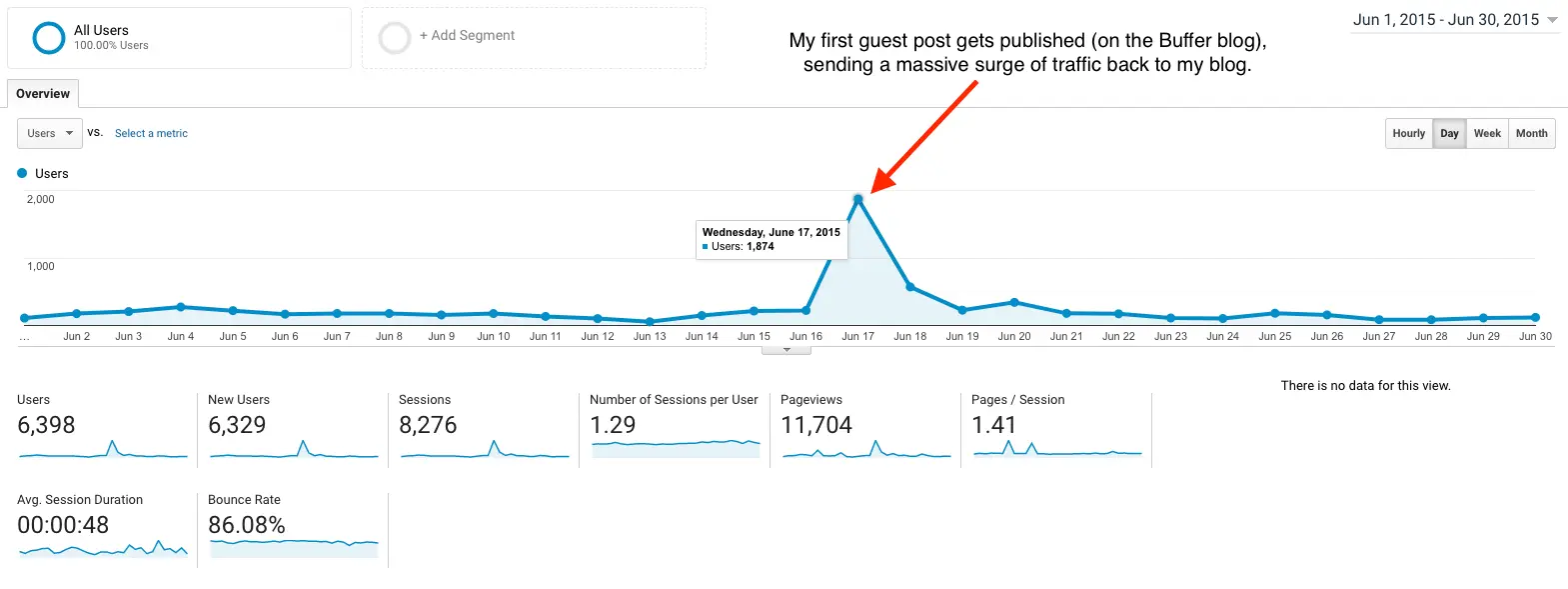
In short, this growth strategy involves reaching out to websites, publications, or other creators who attract the same kind of audience you want to reach, too.
Tip: If you wanna stand out from the crowd with your guest post pitch, invest a lot of time into sending personalized, individually written blogger outreach emails straight to decision-makers, with all the info they need in order to make a decision on your pitch, right then & there.
Launching a guest blogging campaign is pretty simple, overall. Here’s how to do it:
- Outreach & Pitch: In your outreach email, you’ll pitch them on publishing a piece of content, whether it’s writing a blog post, joining an episode of their podcast, or making a video for their YouTube channel. Make the pitch short, straight to the point, and compelling by identifying a gap you can fill in the target site’s content map.
- Create the Content: This is the fun part. Write your blog post draft, show up for the podcast interview, make your video, or co-host the livestream session with the brand or creator you’re collaborating with.
- Publish (and Build Links): The goal of getting a guest post published, is two-fold—first, to reach an audience that might be interested in your content, and second, to build high quality links back to your website. Search engines like Google care a lot about high quality backlinks, so while you can expect to often get traffic spikes of new readers, the long-term goal of guest blogging is to consistently build quality links back to your website over the course of months and years. This’ll help your content rank higher in organic search results over time.
For example, several years ago I wrote a guest post for the HubSpot blog on how to email really busy people:
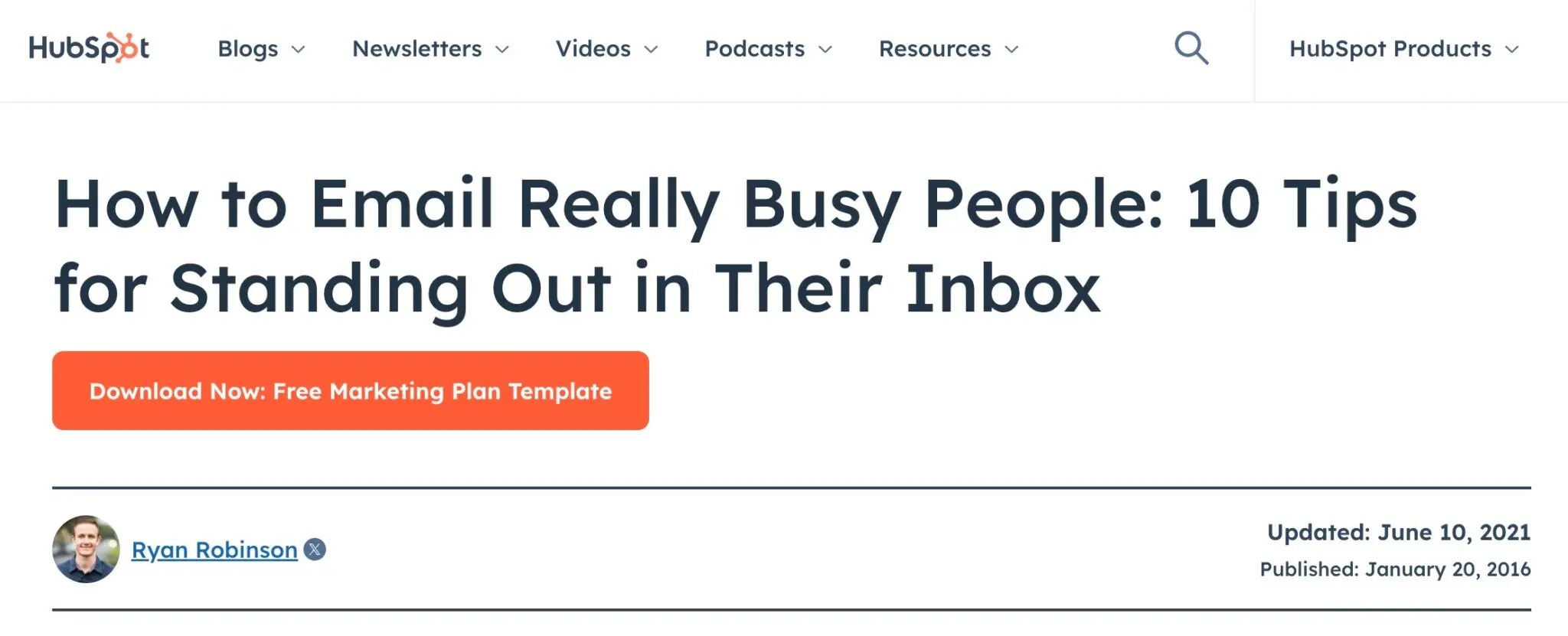
Throughout the post, I mentioned CreativeLive, a past employer I worked for at the time, and included links to both CreativeLive classes and to relevant resources on my own blog. This post still gives my blog a lot of SEO benefits, more than 8 years after the content went live. So, let’s recap:
The Benefits of Guest Blogging:
- Authority and SEO: Publishing on reputable websites boosts your SEO. Links from authoritative sites can help your site rank higher in Google search results.
- Targeted Traffic: Guest posts bring readers directly to your site. Depending on the publication’s size, you might see a spike in readership.
- Personal Branding: When potential readers Google your name, they’ll see you’ve been published on reputable sites, boosting your credibility.
Remember that in your outreach efforts, persistence will be the name of the game. If you don’t get a reply to your guest blog pitches within a few days, don’t be afraid to follow up! I recommend a regular follow up schedule, until you hear back a definitive answer either way.
2. Blog About Long-Tail Keywords for SEO Traffic
Targeting long-tail keywords with your written content efforts through a blog, is no doubt a long-term strategy, but it’s one of the most valuable investments you can make today, that’ll compound your traffic over time—if done right.
Here’s an example of a long-tail post I wrote on the topic, “Are keyword tools accurate?” after getting this question from readers, and identifying it as a commonly searched term online, too:

This post drove around 1,100 readers to my blog within its first two weeks, and continues to stack up more traffic as time marches on.
Multiply this strategy by hundreds over the course of months & years of publishing content on your blog (targeting long-tail keywords that get less competition), and you’ll have a sizable, diversified portfolio of traffic drivers to grow your audience from organic Google search results.
Tip: Future-proof your SEO traffic efforts by choosing long-tail keywords where you can educate your audience that discovers your content, rather than seeking to only answer quick questions. Education intent keywords will still deliver traffic to your blog. Google’s AI Overviews (aka SGE or Search Generative Experience) will continue to wipe out more of the quick answer-style content and replace it with AI-powered answers to queries like this:

However, take a look at how attribution is being done here—the AI Overview clearly cites the top sources, encouraging searchers to click through and learn more. It’s essential to understand Answer Engine Optimization (AEO) as well and factor that into your content as you write.
While some search queries will end right here with a quick overview answered by AI, anyone who’s actually interested in going deeper on their knowledge quest (the real people you want to build an audience with, anyway), will want to hunt down a reputable, authoritative source to keep reading and learning from.
Stop caring about traffic as a metric, and shift your focus to encouraging email newsletter sign ups, where you can foster those new audience relationships.
How to Target Long-Tail Keywords:
- Keyword Research: Use free tools like RightBlogger’s Keyword Tool to identify long-tail keywords that fit your niche and have less competition than other higher volume terms in your space.
- Create Valuable Content: Write an in-depth article addressing the crux of the problem, question, process, or theme of the topic at-hand. Put yourself in the shoes of potential readers—which title would you click on from a Google search result? How would the post look and feel? What would the key takeaways be?
- Optimize: Make sure your content is optimized for search engines to maximize it’s visibility in Google search results (this is your on-page SEO fundamentals).
Once your long-tail content is live, promoting it through guest posts, companion videos for your YouTube channel & short-form platforms, and through posts on the social platform(s) where your ideal audience spends their time online, will go a long ways in your compounding efforts over the course of months and years.
3. Creating Video Content for YouTube
YouTube is the second-largest search engine in the world. I’ve found that creating valuable, longer-form videos for YouTube can significantly speed up your efforts to grow an audience—and build genuine connections with them.

My channel is still modest today, with just over 5,000 subscribers, but some of my videos have 10,000+ views. There’s also a long-term payoff to making great videos for YouTube, with most videos continuing to deliver more views months and years after publishing.
Why video is important today: As a format, video allows you to not only showcase your knowledge in a way that’s accessible and more engaging than written content, but you’re also able to build much stronger connection & levels of trust with your audience. Plus, YouTube is an incredibly popular platform to grow an audience by getting your videos (on helpful topics) discovered.
Think about this hypothetical example in your own life… you’re shopping and comparing a sizable upcoming purchase decision between two seemingly similar options:
- Company A creates high quality actionable video education about how to use this product to get the best results, and shares this content across their social channels.
- Company B is a business with just a website and little else to offer in their online presence. Maybe they have some blog posts and social accounts, but they’re not really present there.
Which company are you more likely to choose to do business with? All other things equal, I’d without a doubt choose Company A, the one that’s making great video education content and confidently standing behind it, 10 out of 10 times.
Tips for YouTube Success:
- Teach Something Valuable: Share skills, experience, or knowledge that your audience (and future audience) can benefit from. What are you already good at or interested in becoming great at, that you can educate others about? This will be the broad topic are to establish your YouTube channel around.
- High Quality Production: Like it or not, high quality videos are the way of the future. That doesn’t mean expensive cameras and fancy microphones are the only option, but it does mean you’ll need to be thoughtful about the environment you film in. Make sure your videos look as polished as possible, and that your sound is crisp & clear. If the quality is too low, viewers will leave and search for alternatives.
- Consistency: Regular uploads will help you stay in front of your growing audience, and send positive signals to the YouTube algorithm that shows you’re a regular around these parts. Both are important to growing your audience on YouTube.
4. Leaning into Short-Form Video Content
Short-form videos are perfect for capturing attention quickly, and once you know what you’re doing, have a pretty (comparatively) high likelihood of getting thousands of views—or even going viral for a hot minute.
Platforms like YouTube Shorts, TikTok, and Instagram Reels are excellent for this type of short-form, in the 1-minute range content.
For example, we recently began posting a sizable number of high-quality videos on our RightBlogger TikTok account, and have been seeing engagement go up the more we post:
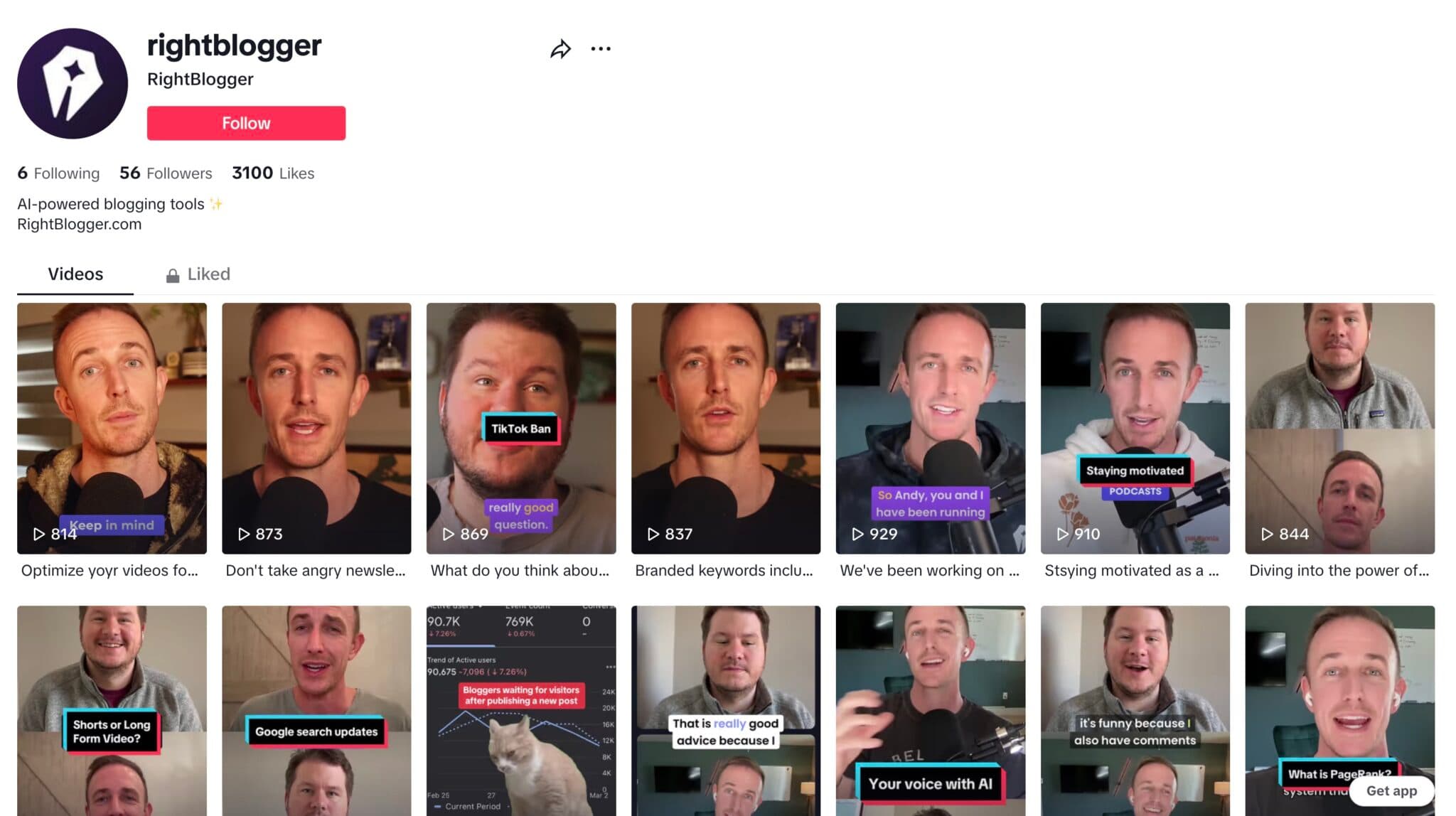
Short-form video is another game where consistency and quality pay huge dividends, but at the end of the day, your ability to hook a viewer from the first couple of seconds is what will make you successful with short-form video—and help you grow an audience on these platforms.
Benefits of Short-Form Video:
- Quick Engagement: Catchy, short videos under 1 minute in duration, can grab the attention of your target audience, immediately. The downside however, is that attention is a fleeting thing with short-form video, so it’s a numbers game to not only get discovered, but keep your audience coming back for more.
- Massive Reach: With hundreds of millions of users across platforms like TikTok, Instagram Reels, and YouTube Shorts, these platforms can expose you to a much broader audience than what you’ll get from just long-form video reach with traditional YouTube videos.
- Relatable Content: Getting a short-form video to take off is all about educating and/or entertaining. If you can teach specific skills or processes, share quick punchy tips that resonate with people, and put a smile on someone’s face in less than a minute, then this world is your oyster, my friend.
5. Building an Email Newsletter List
Having an engaged email list is invaluable for any business. It allows you to connect with your audience directly, in one of the spaces with the least amount of noise (an increasingly difficult thing to find these days).
I’ve sent weekly emails to my audience for nearly a decade, sharing new blog posts, videos, and podcast episodes I think my audience will enjoy and benefit from. Here’s a snapshot of how the 813,000+ emails I’ve sent to subscribers have performed over the last 90 days:
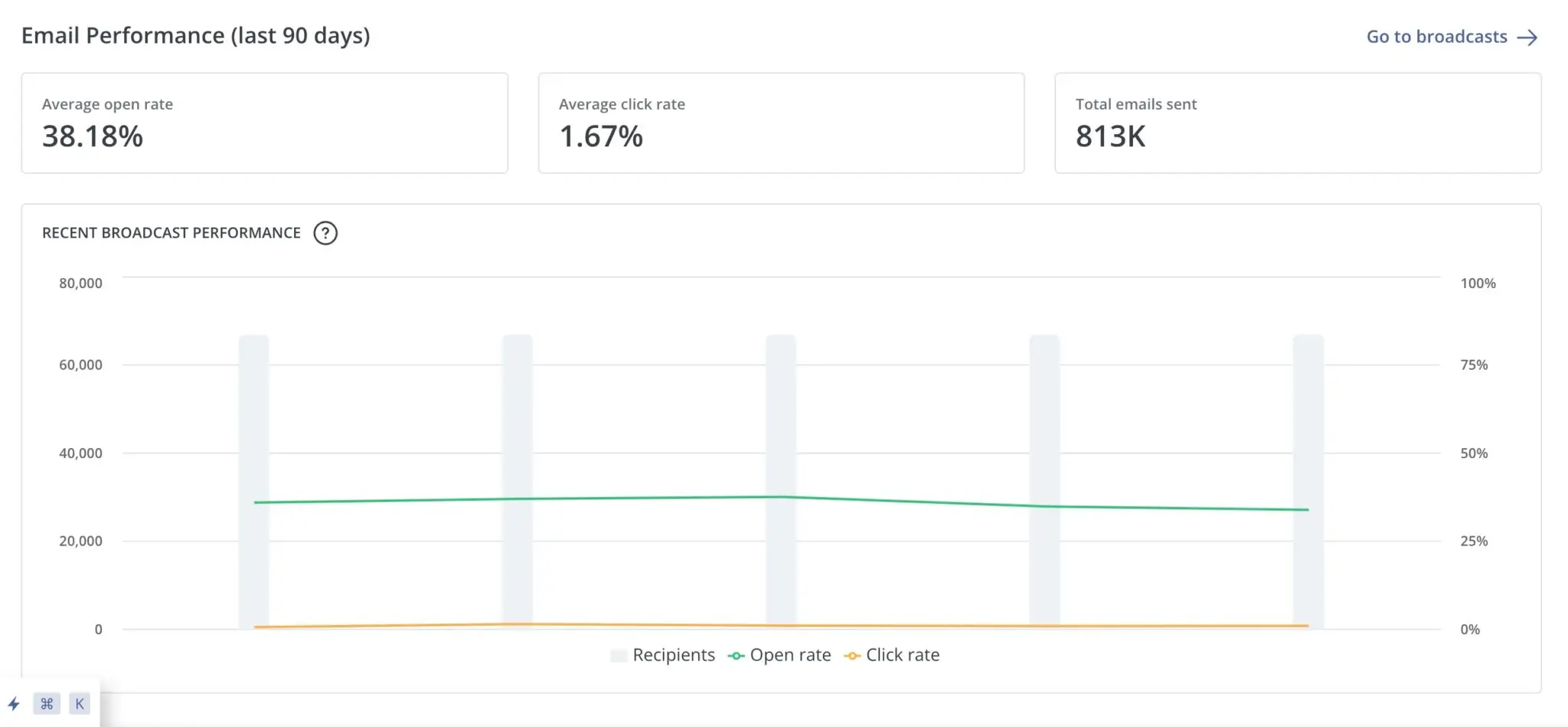
This kind of consistency builds a level of trust with my subscribers, and that’s empowered me to monetize with my audience in extremely creative ways over the years.
From pre-selling courses and generating $30,000+ in sales before even making the content, to launching RightBlogger with a massive influx of new customers on day one, your email list will be one of the best places to sell to your audience. It’s smart to begin building your community right from the start (or today 😉).
Quick Steps to Building an Email List:
- Create a Signup Page: Choose a platform like ConvertKit or Mailchimp (both have free plans) and use their tools to either make a quick landing page or embed a form onto a page of your blog. Add your Newsletter page to your top & footer menus, and begin mentioning (and linking to) your newsletter throughout your content, so it’s easy for visitors to subscribe.
- Offer a Lead Magnet: Most people don’t get excited about just signing up for another newsletter. Offering new audience members a free course, template, resources, or tool in exchange for their email address, is a great way to increase your sign up rates.
- Consistent Communication: Once people begin joining your email list, you’ll have to regularly send valuable content to those subscribers, otherwise they’ll quickly forget who you are and why they even came to your site in the first place.
6. Answering Questions on Discussion Forums like Quora and Reddit
Answering questions on platforms like Quora and Reddit can help you grow an audience by providing real value to fellow community members, and positioning yourself as an expert in your field.

For example, my answer (above) on Quora guiding someone new to blogging about how to increase their blog traffic, got hundreds of upvotes, has driven meaningful engagement with my account, and sent traffic to my website for years now.
Tip: Trust and your reputation are everything on these community platforms. Both are difficult to earn over the course of months and years of being an active contributor, and both are easy to destroy by being overly self-promotional when there isn’t an obvious, natural, tasteful fit to mention your business or point readers to your content back on your blog. When you promote yourself, be cool about it.
How to Engage on Forums:
- Be Genuine: Offer real value without being overly self-promotional on sites like Quora and Reddit. Most people on these forums are here to learn from their peers who’ve already been through a particular (often very niche) experience they’re seeking answers about. Respect that and seek to foster relationships with people within your audience on these platforms, and over the course of months & years, you’ll benefit immensely.
- Include Links: Done sparingly and tastefully as you begin building a reputation as a helpful contributor on your topics, you can link to relevant content (or products) on your site and expect to see some highly targeted traffic come over once you’ve built up momentum.
- Build Trust: Consistent, helpful contributions will build your reputation as a valuable person within the community, over time. But there’s no shortcut to this one, it really does take time to build trust. That means you have to really enjoy publishing on these platforms, or help yourself along the way with tools like RightBlogger’s Expert Reply Tool.
7. Getting Interviewed on Podcasts
Pitching yourself as a guest on podcasts in your niche can expose you to new audiences at light speed. Podcast hosts need great stories to tell, and want to regularly deliver value to their audiences—that’s where you come in as an expert in your field.
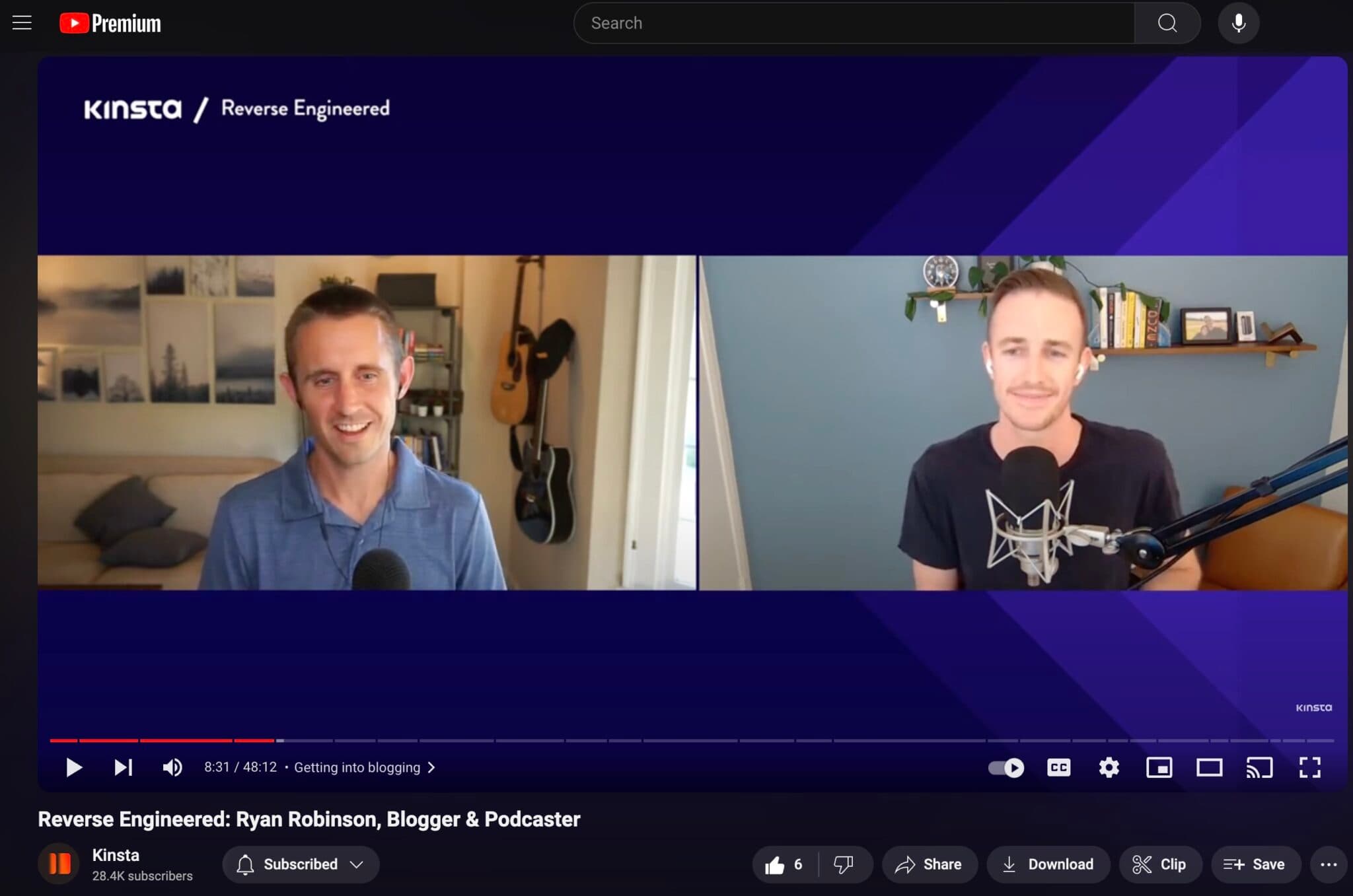
I’ve found that podcast appearances not only allow me to share my story with potential new audience members, but they also give me very valuable backlinks to my site, which helps improve SEO for my content overall.
Guesting on podcasts is an easier form of getting in front of the right audiences for me today, because I’m now very comfortable on camera & have some interesting stories to tell. Guest blogging is often a lighter lift starting point if you’re brand new in your creator journey.
Tips for Podcast Interview Success:
- Craft a Compelling Pitch: The first question a (busy) podcast host is going to ask themselves when you land in their inbox, is why this person? Highlight why your story is unique, interesting, and clearly spell out the value you’ll bring for their listeners (and ideally, to the show in general too).
- Work with Hosts: Make the process easy and beneficial for them by being a low effort guest. Don’t make a fuss about scheduling, getting the questions in advance, or inquiring about how they’re going to promote your episode, and you’ll maximize your chances of making it through to publish date.
- Follow Up: Most people hosting a podcast are wearing a whole lot of other hats. Don’t be afraid to follow up on your pitch to be a guest on their show, and once your episode does go live, hit them up if they forget to include links to your site in the episode’s blog post or show notes.
8. Being Active in Social Communities
Engaging in social communities where your target audience spends their time is a great way to build an audience, and create relationships that can stand the test of time.
Facebook groups, Instagram, Pinterest, LinkedIn, and Twitter can all be great platforms depending on your niche. Sprout Social has a fantastic report on who spends their time on which social media platforms, which will steer you in the right direction on deciding where to spend your social time.
Tip: Creating your own mini social community can be one of the best ways to establish yourself as an expert and high value contributor in your space. Take for example, the Passive Income Pathways group on Facebook, operated by my friend, Sadie Smiley. She has over 21,700+ members with TONS of active discussions around passive income-related themes going on every day, and Sadie’s been able to shape her own business around this group at the center of her new audience growth strategy.
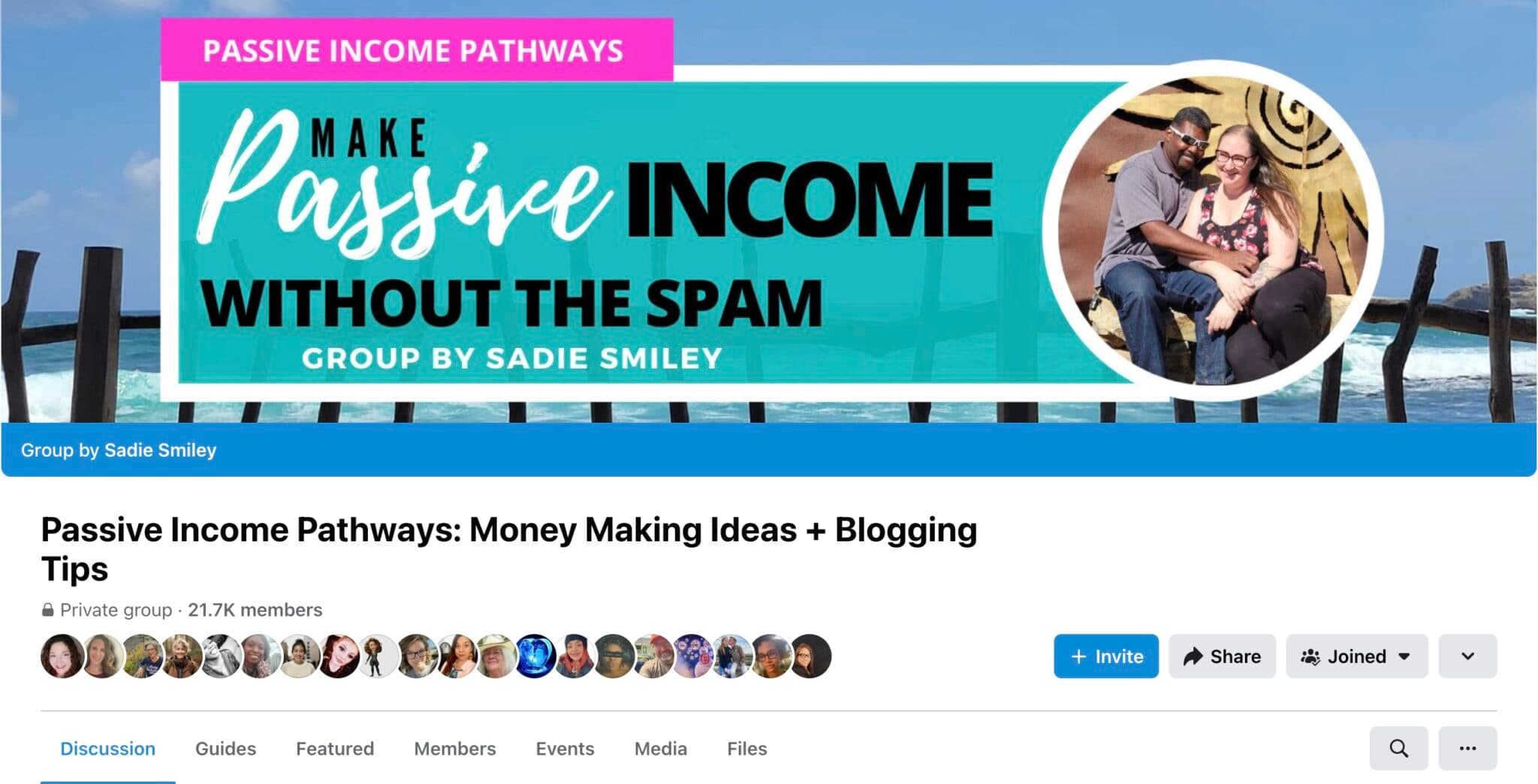
Creating your own group is major extra credit though. You can get really far simply by being present and sharing valuable content with your audience on whichever platforms they’re using. Just be sure to keep it real and don’t go overboard on the self-promotion.
How to Engage in Social Communities:
- Post Only on Relevant Social Networks: Participate where your target audience is already present and active. Be sure to know the rules of the road though, so that you’re creating content in a format that users expect, and will resonate with. Pay attention to how successful creators on each platform are doing their thing, and you’ll learn a lot.
- Contribute Value: Value has to come first, otherwise you’ll get ignored by people who are looking for genuine help without strings attached. Share valuable insights and support other members 99.9% of the time, test the waters of tasteful self-promotion when there’s a clear fit, very slowly and infrequently.
- Build Relationships: Genuinely helpful content and positive interactions lead to long-term engagement and trust on social media platforms too, whether we’re talking about groups or the more publish/follower style platforms like Instagram, LinkedIn, and X (Twitter).
You Can Grow an Audience on Any Platform… But…
… you do need to choose wisely. If you invest all your time into building an audience with strategies that don’t play to your own strengths & interests, or you go deep on platforms where your audience hardly exists, you’re burning time (and money).

And like I said at the start of this party, these are highly effective ways to grow an audience online today, they’re not necessarily easy or fast—though some of them, when you’re leveraging your own strengths right, do get pretty easy.
Whether you’re just starting out with building an audience, or looking to expand your reach through new platforms, these strategies will help you build a sustainable, engaged audience (over time). Remember, growing an audience takes time and effort, but the rewards are so worthwhile.
Be patient, deliver consistent value, and watch your audience grow.
What is the fastest way to grow an audience from zero in 2025?
The fastest path is to borrow attention from people who already have your target audience. That usually means guest blogging, podcast interviews, or collaborations.
Start with 10 to 20 websites, podcasts, or creators your audience already follows. Pitch one clear topic that fills a gap in their content, and make it easy for them to say yes.
After you publish, send that new audience to one simple next step, like joining your email list. If you skip that step, the traffic spike fades and you have nothing to build on.
Keep going for a few months. Audience growth is usually slow at first, then it speeds up once you have proof, links, and a backlog of content.
Are long-tail keywords still worth it with Google AI Overviews?
Yes, long-tail keywords are still worth it, but you should focus on topics that teach, not just quick answers. Educational posts give people a reason to click through and keep learning.
Pick long-tail questions that need examples, steps, or a full guide. These are harder for AI Overviews to fully replace, and they can still send you qualified traffic.
Do keyword research, then write one strong post that actually solves the problem. You can use RightBlogger’s keyword research tool to find low-competition phrases that fit your niche.
Then add a clear signup offer inside the post. The real win is turning search visitors into subscribers you can reach anytime.
Should I start YouTube or short-form video to grow my audience?
Start with the format you can do consistently for at least 8 to 12 weeks. Long-form YouTube builds trust and search traffic over time, while short-form video can get fast reach.
If you like teaching and going deeper, YouTube is a great pick. If you are better at quick hooks and short tips, Shorts, Reels, or TikTok may fit you better.
A simple combo works well: make one long YouTube video, then cut it into 3 to 5 short clips. This gives you more chances to get discovered without creating new ideas every time.
Track which topics bring the most comments, saves, and clicks. Double down on what your audience clearly wants more of.
How do I turn new visitors into email subscribers (instead of just getting views)?
You turn visitors into subscribers by offering one clear reason to join your list. This is usually a lead magnet like a checklist, template, or short email course.
Place your signup in 3 spots: near the top, in the middle after you helped them, and at the end with a clear call to action. Keep the message simple and match it to the post topic.
Send emails on a regular schedule so people remember you and trust you. Consistency matters more than being perfect.
If you want help creating a strong freebie fast, use ideas from RightBlogger’s guide to AI lead magnets and build something that solves one small problem.
How can RightBlogger help me grow an audience without spending all day on content?
RightBlogger can speed up the parts that usually slow creators down: research, outlining, drafting, and reusing content. That helps you publish more consistently, which is a big factor in audience growth.
Use the RightBlogger AI Article Writer to turn a topic into a solid first draft, then add your real examples and experience. This keeps your voice and makes the content more helpful.
After publishing, repurpose the same idea into social posts, short videos, and email content. A simple repurposing workflow makes each post work harder and reach more people.
If SEO is a priority, review what is already ranking and where you can improve. Using tools like SEO reports for blog content can help you spot quick fixes that improve visibility over time.
Article by Ryan Robinson
RightBlogger Co-Founder, Ryan Robinson teaches 500,000 monthly readers how to grow an online business. He is a recovering side project addict.
New:Autoblogging + Scheduling
Automated SEO Blog Posts That Work
Try RightBlogger for free, we know you'll love it.
- No Card Required
- Blog Posts in One Click
- Unlimited Usage





Leave a comment
You must be logged in to comment.
Loading comments...